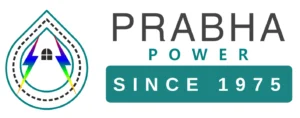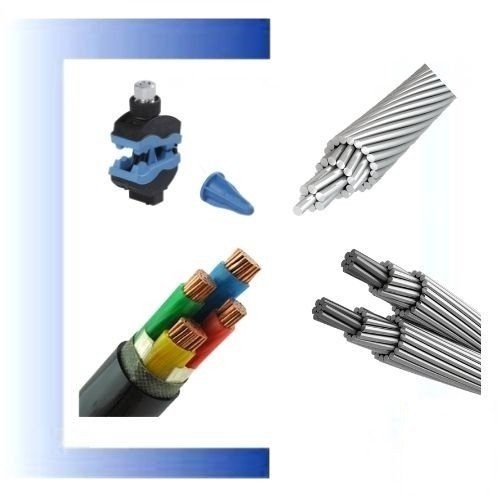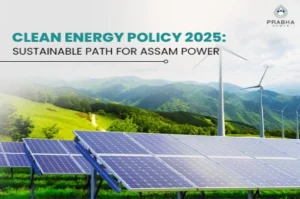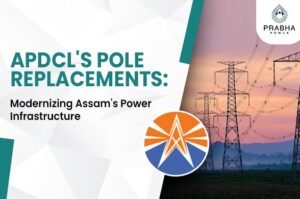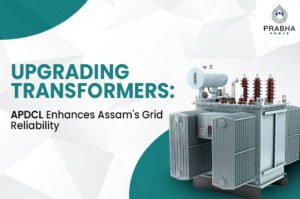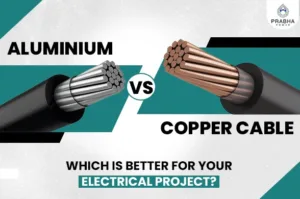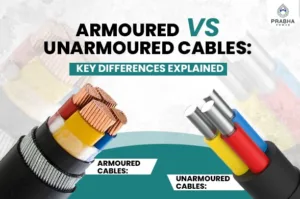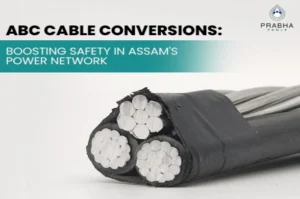
Electrical safety in Assam represents a major challenge and particularly in areas where existing overhead bare wires are life, property and wildlife hazards. Aerial Bunched Cable (ABC) conversions are changing the landscape. ABC installation represents a safer alternative to bare cable, increases the resilience of the power grid, and may be more cost-effective than total underground cabling systems.
Electricity providers can minimize the risk of electrical hazards, lessen electrical interruptions, and improve electric cable safety in Assam with the upgrade to ABC cables. These cable upgrades provide answers to the issues resulting from traditional overhead wiring and are beneficial for safer, reliable power distribution throughout the region.
The transition to cable for electric safety within communities through ABC technology is a sensible and scalable way to modernize the electricity distribution system, whether in urban areas or more rural locations
What Is an Aerial Bunched Cable?
Aerial Bunched Cable (ABC) represents an innovative advancement over conventional overhead power lines, emphasizing improved safety and reliability. ABC replaces the traditional bare conductors strung on poles for bridges with cables that bundle all of the live conductors in one, with each being insulated for safety.
Insulation minimizes the risk of electrical accidents occurring either from electrical faults or contact with tree branches, buildings or a person. ABC includes a messenger wire (or neutral wire), which is used to provide structural support to the cables to keep them in position.
The advantage ABC cable installations provide is the opportunity to continue using the flexibility of traditional overhead lines with safer outcomes; individual conductors minimize faults that can cause repairs. ABC cables provide better protection for people and wildlife while minimizing electrical safety risks. Aerial Bunched Cable is a preferred method of upgrading power networks all over the world when electrical safety is a primary concern, an area of focus for power network upgrades in Assam.
The case for cable conversions to ABC in Assam
In Assam, where power lines are regularly interrupted by weather disturbances, trees and vegetation, and wildlife intersect with power lines take place, it makes sense and is an important step to move from bare overhead conductors to Aerial Bunched Cable (ABC). Here are some reasons:
Bare wires with loose strands are inherently at risk of accidental contact with trees, with buildings, and with animals and humans. ABC cables have each conductor insulated, which substantially reduces the likelihood of risk for electrocution or fires due to contact or falling wires. ABC offers a greater level of confidence for human populations and for wildlife in Assam, where power lines are encountered often and particularly in wooded and rural areas.
1. More Secure for People and Animals
- In areas with dense vegetation or forested areas, bare wire routinely sags or is blown or knocked down by falling branches. This poses a genuine risk to residents, livestock, and wildlife. By using insulated ABC wire, you reduce that risk.
- Accidental contact (for instance, someone accidentally touching a falling wire) results in fewer electric shocks or fires when insulated wire is installed.
2. Reduced Outages and Weather-Related Faults
- Assam is affected by monsoons; strong winds and heavy rain can cause bare wires to short or be damaged. ABC is more robust
- Fewer outages mean fewer complaints and a reliable energy supply to residents and businesses.
3. Reduced Losses and Theft
- Transmission losses are somewhat reduced due to the insulation being able to provide some protection against leaks and reduce arcing.
- Insulated conductors are more difficult to illegally tap for power; therefore, certain kinds of theft or pilferage become more complicated.
4. Improved Functionality in Challenging Terrain
- In hilly, forested or other hard-to-reach areas, trenching for underground cable is costly and sometimes not possible, while ABC provides a better, cost-effective overhead option with some safety benefits.
- Captive bundles fit in narrow streets or in densely constructed towns or areas of tight space and can reduce visual clutter and interference.
5. Aesthetic and Maintenance Benefits
- Cleaner Lines: Less loose wire, fewer cross‑arms or supporting hardware. It looks less cluttered and is easier to inspect.
- Maintenance is also simplified with fewer exposed parts and insulation that protects against external damage.
Potential Issues with ABC Conversions
Although there are many advantages to installing ABC cable, Assam’s power delivery officials may want to consider a couple of challenges. The initial cost to transition from bare wires to Aerial Bunched Cable (ABCs) may be higher than traditional wires because of the cost usually attributed to the specialized materials and engineering that can be required.
Also, should an insulated ABC cable be damaged, whether due to inclement weather or age, the insulation may need to be repaired or replaced.
An ABC’s weight can require the support poles and support structures to be stronger than poles that support bare conductors. The strong poles and support structures may not be readily available in some areas. In spite of potential drawbacks, the safety and reliability improvements make ABC conversions justify the investment in Assam and its power delivery infrastructure.
- Upfront expense: Insulated conductors, superior hardware, and design effort cost more from the outset; you will need to budget for that.
- Damaged insulation: Even though they are insulated, the outer jacket can deteriorate due to sunlight (UV), heat, mechanical rubbing (branches), animal interference, etc. When the insulation is damaged, faults can develop.
- Weight & support: ABC cables are heavier than bare wires. Structures, messenger wires, and span distances need to be engineered to accommodate. Some existing poles may need to be strengthened.
- Fault detection: Because conductors are bundled together, it may be more challenging to locate accurate faults in comparison to individual wires. Smart monitoring, or sectionalisation, may help.
- Voltage & capacity limitations: Very high voltage transmission work is typically still operating on systems that are different. The ABC process is mostly in the low or medium-voltage distribution category.
How to Effectively Plan the Upgrading of ABC Cables in Assam
To ensure a successful transition to Aerial Bunched Cable (ABC), local authorities and utilities or a company such as Prabha Power, must have a structured and well-planned approach. The first step would be to review the power company’s system in its entirety and catalogue its weaker points to prioritize areas of concern like reliability or safety.
After evaluating the existing conditions, a full load assessment and environmental review should take place to assess each zone to properly identify what to design the individual cables to. One could run a pilot project by zones to gauge their respective weaknesses, once pilot project evaluations provide both evidence and comfort, roll out the full implementation of the improvements could take place.
Also, training field staff on specific ABC installation and maintenance should take place to ensure staff management is of the highest capabilities. Finally, hot and cold roll out of creep values to capture ongoing value improvements, if needed, to sustain the integrity and function of the power system.
Mapping and Surveying
Recognize areas of concern: where the wire is sagging, areas of frequent fault, proximity to wildlife areas and in densely populated urban settings.
Load and Environmental Analysis
Measure load requirements, temperature extremes, rainwater levels, UV exposure and wind loading. This assists in selecting an appropriate cable design (wire insulation, fixed diameter of conductor and messenger severity).
Design Specification
Select isolators rated for Assam’s temperature, UV classified rating, and moisture resistant. Span length and clearance, pole strength. Identify relevant Indian specifications (IS) related to ABC cables.
Pilot Projects
Try conversions in a small, representative stretch: maybe in a forest fringe town or a dense urban lane. Monitor performance, maintenance needs and public response.
Training and Safety Procedures
Staff in the field, contractors, and locals all require training; how to handle insulated cables, what clearances are required, and what the response should be when an accident occurs.
Regular Maintenance and Monitoring
Inspect the insulation; inspect the supporting hardware; clear vegetation; monitor for fault detection . Include sensors where possible.
Phased Roll‐out
Focus on the highest risk zones (schools, hospitals, forest edge, wildlife corridors). Then iterate slowly.
Best Practice for Safety and Longevity
For ABC cable conversions to achieve maximum benefits, it is advisable to observe best practices with regard to safety and longevity. Start by selecting materials for insulation that are both UV-resistant and rated for extreme weather conditions.
Regular maintenance, including a wear-and-tear inspection of the insulation, should be in place to find potential problems before they become significant failures. Affected cables that are clear of trees, buildings, and roads should have appropriate clearances to prevent mechanical stress and damage to both the cable and insulation.
Reinforced poles and/or support structures are imperative for maintaining the structural integrity of the infrastructure, especially in high wind or heavy rain regions. Finally, install fault detection systems and schedule inspections at regular intervals to discover and mitigate these situations as early as possible, prolonging the serviceable life of the network and providing consistent, safe power.
- Select durable materials: For example, UV-stabilised insulation, high tensile support wires, and insulation compounds that resist moisture.
- Maintain adequate clearance: From trees to structures to roadways – insulated cables can degrade just by continuous rubbing or stress, even when insulated.
- Consider using reinforced poles or supports if spans are long or the wind load is high.
- Regular inspections: Especially follow storms or heavy rains, or for the seasonal monsoon.
- Community awareness: Residents should know why lines are changed, avoid tampering, and report sagging wires.
Conclusion
Transitioning to Aerial Bunched Cable conversions provides a real opportunity to enhance safety across electrical cables in the region of Assam. For example, ABC cables enhance safety by lessening risk, reducing outage frequency, and eliminating theft. ABC cables are a modern solution to enhancing safety in the power infrastructure that is more effective and economically smart.
Additionally, the flexibility to install ABC cables in Assam’s varied terrain and conditions is a true benefit, ultimately providing a safer and more reliable way to land power across the state while working to improve the longer-term efficiency and sustainability of electrical infrastructure in Assam.
If you want to be part of this transformation through infrastructure building, supply chain partnerships or engagement of the projects, Prabha Power is your partner! Prabha Power is one of the leading electrical infrastructure and construction materials suppliers in Assam and the Northeast and will play a key role in advancing the transformation in the state.
Please contact us at 093948 79486 for more information or enjoy developing your project with us!
